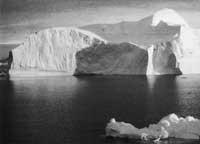Volcano under the ice
If the volcano found in the South Pole is lit, the local ice layer would melt.
This volcano was investigated in an observation work carried out in 1987 by Donald Blankenship. Its footprint was the rapid melting of a part of the ice sheet.
Blankenship was part of the prestigious observatory Lamont-Doherty, the most complete of devices and techniques of the Earth. The objective of the investigations was to know precisely the Antarctic. What at first was only intuition, it had to be demonstrated, so he later performed the measurements again with his companion Robin Bell. The width and height of the ice, the magnetic field and the gravitational attraction of the stone floor were measured, among others.

Blankenship, if one layer of ice melted faster than another, it was evident that it was due to the existence of a hot source. Some researchers did not agree with these arguments, but in 1992 Blankenship showed the presence of a volcano in the south latitude of 81° 52.6 and in the western longitude of 111° 18.1”. The width of the ice layer in this area is 2.000 m and in view of the eyes no great changes of relief are observed. But thanks to the radar, a 650 m high mountain under the ice has been discovered.
According to magnetic measurements, it has been observed that the aforementioned mount has a lot of magnetite and that its presence is characteristic of the volcanoes. A cone has also been detected by gravity measures. The diameter of the cone is 6 km and the depth of 50 m. There the ice melts without interruption.
Other measures have shown that the volcano provides a power of between 10 and 50 W per square meter. Since this power is 1000 times higher than that provided by the earth's crust, it is concluded that the volcano is not dull and asleep.
There are other volcanoes around Antarctica, but this has been the first discovered under ice.





